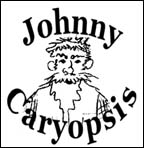
Giant Hyssop
| By Shirley Froehlich | (Click links for more images.) |

An article in Landscape Trades magazine for the Canadian Nursery and Landscape industry caught my attention recently. Our very own prairie native, Giant Hyssop (Agastache foeniculum), was the "Plant of the Month" in an article written by John Valleau of Valleybrook Gardens, a very large perennial grower in Ontario and B.C. It seems the nursery industry is beginning to see the value of some of our prairie species.
Giant Hyssop certainly has lots of things going for it. It blooms throughout July, August and into September. The flowers are alive with bees and butterflies coming for a drink from the nectar filled flowers. Goldfinches visit to eat the seeds too. It doesn't need to be left entirely to our wildlife visitors either. The licorice flavoured leaves make fine herbal teas and jellies or can be included fresh in salads.
I have found that it dries well for arrangements with long, sturdy stems. The flowers dry to a distinctive navy blue. It is also good as a fresh, cut flower. In fact it has been taken to Holland where selection and breeding work is going on to develop especially good forms for the commercial cut flower industry.
DESCRIPTION
This bushy, upright plant forms a nice sized clump and grows up to 90-100 cm tall (3 ft.) on the prairies. It is a member of the mint family with square stems and opposite leaves. The ovate leaves are medium green with a paler green underside. They are 2.5 to 7.5 cm long (1"-3") with a serrated edge. The 10 cm (4") lavender flower spikes are made of many small, tubular flowers packed together. Each plant produces a mass of flower spikes which results in a very attractive plant.
NATIVE HABITAT
Giant Hyssop has a fairly wide range. It can be found down through the mid-western United States as well as across the Canadian Prairies in Manitoba and Saskatchewan. I have seen it growing in both Bird's Hill Park and Riding Mountain Park in Manitoba. It grows in open woodlands, edges of aspen poplar groves and semi-open prairies.
CULTURE
In the garden Giant Hyssop grows very well in full sun or part shade. It tolerates a wide range of soils. Medium to moist soil is best, however the plant is quite drought tolerant once established. It self seeds somewhat, but not to the point of being a problem.
Bees are attracted to Hyssop flowers.
Groups of Hyssop can be used in newer beds where it makes a reliable, sturdy perennial for the middle or back of the border. It also mixes well with other wildflowers and native grasses to create a prairie meadow. It grows well in combination with other native species such as Early Blue Violet, Wild Strawberry, Northern Bedstraw, Canada Anemone, American Hedysarum, False Sunflower, Smooth Aster, and Hairgrass. This combination will give an ever changing tapestry of colour and texture throughout the growing season in either full sun or part shade.
Giant Hyssop can be started from seed indoors, or plants can be purchased to set out in spring after the danger of frost is past, or in summer. If you wish to start your own plants from seed indoors, they can be seeded in late March for planting outside in early June. The seed germinates in 6-10 days with bottom heat around 21 degrees C. Bottom heat can be provided by heating cables or by setting just above a hot air register until germination begins. Plants will bloom the second year from seed.
Giant Hyssop is a beautiful all around perennial for both prairie meadows and flower beds. Its abundant nectar and seed attract bees, butterflies, and birds to enrich your garden with flight and song. Cut and dried flowers enhance our homes and the leaves make tasty herbal teas.
|
Hyssop Tea
By Johnny Caryopsis

You can use hyssop tea as you would any other tea. You'll probably need to experiment a bit to find out what concentrations you prefer. A regular tea ball filled with hyssop can suffice for a full pot of tea or you can use it to supplement regular teas. A tea ball of hyssop and one tea bag of regular tea makes a nice combination.
There are a couple of things to bear in mind when harvesting hyssop for tea. First of all, check the plants to see if they contain the flavoured oils. Sometimes individual plants have little or no flavour. Whether this is a genetic trait or the result of environmental conditions isn't known. You can test for flavour by picking a leave off the plant. Crush and roll it between your fingers, then take a sniff. If you smell the licorice scent strongly then the plant will make good tea. If not, look elsewhere. And, wherever you are harvesting, be it your garden or from the wild, don't remove all the plants for tea. Always leave at least half the "crop" so the plants will be able to grow for the rest of the season and replenish themselves for next year's harvest. It's OK to use our natural heritage, provided you conserve it for tomorrow.
|
Thanks for learning about Giant Hyssop! Bye for now!
| You can help NatureNorth produce more great articles with a secure donation through PayPal. Our Google Adsense ads pay our server costs, but that's about it. To learn more follow this link: Support NatureNorth. Thank-you! | |
Return to: Summer Issue | NatureNorth Front page
